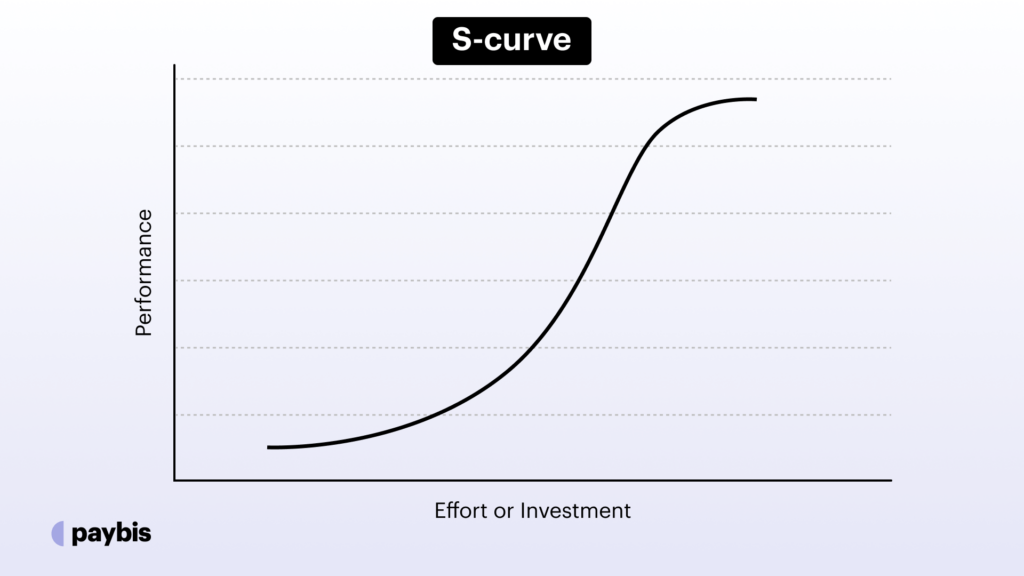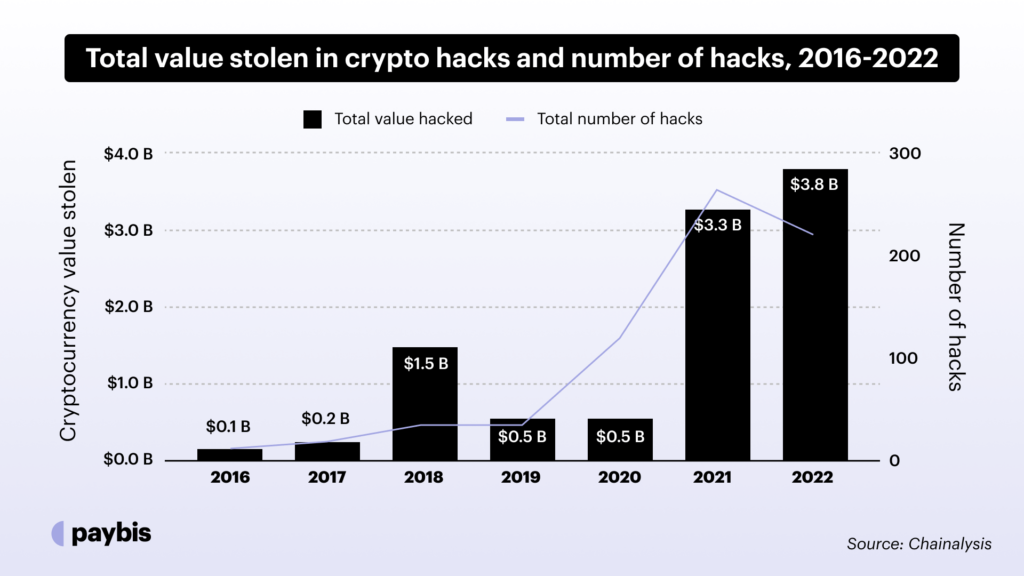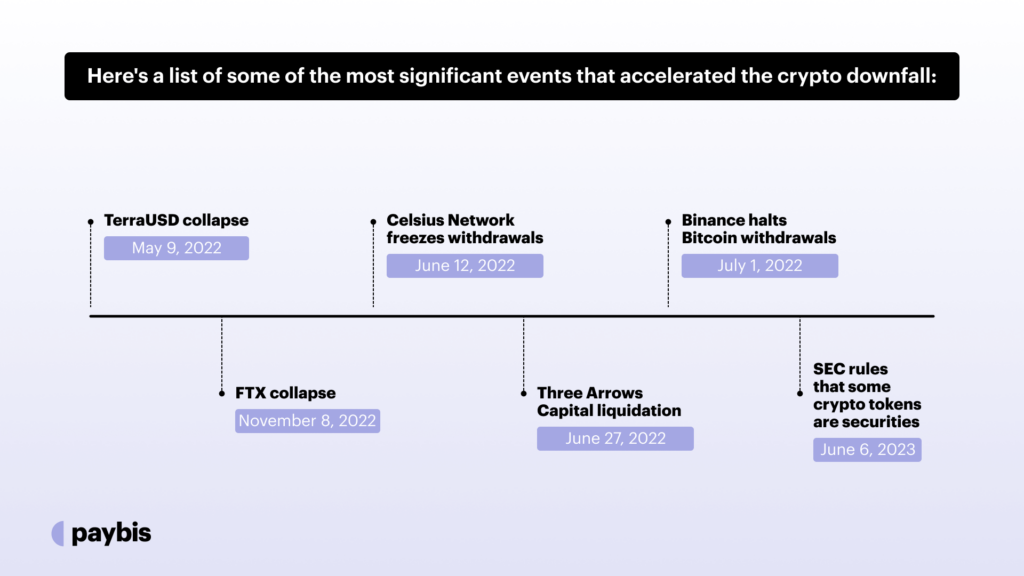Is Crypto Dead?
Is crypto dead – a question that everyone from high school teenagers to large governments have asked at least once over the past few years. While not necessarily complex, the unfamiliarity of the technology underpinning cryptocurrencies is difficult for most to grasp.
Some argue that crypto is dead, while others say it is thriving and will continue to do so. So, which opinion is more substantive?
The first cryptocurrency, called DigiCash, debuted in 1990. It was considered a revolutionary new form of money but failed to gain traction and eventually died off due to its inherent drawbacks.
Since then, several cryptocurrencies have been created, but none made it until almost two decades later, in 2008 – Bitcoin.
Yet, the cryptocurrency market still remains volatile, with a lot of regulatory uncertainty.
From the exhilarating highs of Bitcoin’s unprecedented price surges to the gut-wrenching lows that left skeptics gleefully pronouncing the death of crypto, the narrative surrounding digital currencies has been anything but static.
Headlines have oscillated between declaring the end of an era and heralding the dawn of a financial revolution. But amidst sensationalism and fervent debates, the question remains: Is crypto dead, or are we merely witnessing a new phase in its evolution?
This article dives into the current state of cryptocurrency to gain a complete perspective on its potential future.
Table of contents
The Crypto Roller Coaster: A Brief Recap
To understand the current state of cryptocurrencies, it’s essential to reflect on the turbulent journey they’ve undertaken since their inception. From its humble beginnings in the aftermath of the 2008 financial crisis, Bitcoin emerged as a decentralized alternative to traditional currencies.
Cryptocurrency first rose to prominence in 2017 when Bitcoin’s value reached an all-time high of nearly $20,000. At the same time, blockchain and its underlying technology were still relatively unknown to most people outside the tech world.
As the cryptocurrency market expanded, other digital assets like Ethereum, Ripple, and Litecoin joined the fray, each with its own unique value propositions and use cases. However, this expansion was accompanied by extreme price fluctuations, creating an atmosphere of speculation and uncertainty.
In recent years, Bitcoin’s price has become more stable, but it still experiences significant volatility. For example, Bitcoin’s price reached an all-time high of $68,789 in November 2021, but it then crashed to $33,000 in July 2022.
There have been a number of significant events that have contributed to extreme price fluctuations in the crypto market. For example, the collapse of the TerraUSD stablecoin in May 2022 caused a sell-off in the crypto market, with Bitcoin losing over 30% of its value in a single day.
Despite the extreme price volatility, the crypto market has shown remarkable resilience. After each crash, the market has always recovered and reached new heights. This is due in part to the underlying technology of blockchain, which is decentralized and secure. It is also due to the growing adoption of cryptocurrencies by businesses and institutions.
The Current State Of Crypto
The crypto market is currently in a state of flux. On the one hand, Bitcoin and other cryptocurrencies have become increasingly popular with investors and businesses looking for an alternative to traditional currencies.
On the other hand, there are still many regulatory uncertainties surrounding cryptocurrencies. Government authorities around the world are trying to figure out how best to regulate digital assets, but most countries are still in the early stages of implementing such measures.
Despite regulatory challenges, cryptocurrencies are becoming increasingly popular with institutional investors. Banks and major corporations like JPMorgan, Microsoft, and PayPal have all started offering cryptocurrency services to their customers.
On the Path to a Billion Users
“My guess is that in 10-20 years, we’ll see a substantial portion of GDP happening in the crypto economy,” said Brian Amstrong, CEO of Coinbase, last year.
Everyone talks about having 1 billion users in crypto and mentions how it is still in its infancy and needs time to evolve. But only a few truly understand how technology evolves. The image below can help you visualize that.
The horizontal axis represents the expended development effort, encompassing human and economic resources. The vertical axis illustrates the technology’s performance, gauged by its predominant parameter of significance.
The early stages of researching a new technology are marked by slow progress due to limited knowledge and expertise, leading to continuous obstacles.
However, once vital technical challenges are overcome, a small additional investment triggers rapid improvement. This phase is followed by a plateau where sustaining growth requires increased investment or accepting slower progress, signifying the technology’s nearing limits.
The number of crypto users is expected to amount to 994.30m users by 2027″, according to Statista. This is a good sign; however, calculating the real users is a complicated task.
Crypto is often compared to the Internet in its early stages, but for the Internet, it was easier to calculate the number of users, with the crypto it is not the same we cannot calculate numbers based on active addresses, as with the blockchain technology it gives the power to be pseudonymous (or anonymous) thus one person can have multiple addresses (and even identities).
Nevertheless, if builders focused on reducing complexities for the average users and solving real problems, we can surely see the mass adoption of the technology.
Crypto is Dead if Cyberattacks Are Not Stopped
The increasing frequency and sophistication of cyberattacks within the evolving crypto market, particularly in the realm of DeFi protocols, pose significant threats to the future viability of cryptocurrencies.
In 2022 alone, a staggering $3.8 billion was stolen from crypto hacks, with a substantial portion originating from vulnerabilities within DeFi projects.
DeFi protocols, while offering innovative financial solutions, often fall prey to these attacks due to the combined effects of being open source and being in a rush to introduce the “next big thing,” which can often lack the necessary security protocols.
As a result, hackers exploit code vulnerabilities and get away with financial carnage.
Instances of wallet theft and compromise have left users susceptible to attacks, jeopardizing their crypto holdings and undermining the trust in the technology’s security. Not all wallets are as secure as the Paybis Wallet. Some fall short, and their users eventually pay the price.
When choosing a wallet, do your own research thoroughly to keep your assets safe.
So, is the crypto market dead from hackers? Well, certainly not. But to repel hackers from draining wallets, crypto needs robust security measures from various startups around the world.
One thing to note is that crypto will not flatline as long as the internet exists. While governments can ban, restricts, or sanction cryptocurrencies, the distributed nature of blockchains and their provision of anonymity to users will enable them to keep in business. However, at Paybis, we strongly advise against engaging in any activity that goes against the laws governing your region.
Then why is crypto crashing?
Why is Crypto Crashing?
The cryptocurrency market is known for experiencing waves of euphoria and fear.
Crypto price charts reveal that, historically, the cryptocurrency market has experienced a long period of bullish sentiment followed by a shorter period of bearish sentiment.
Over the last few months, there have been a slew of events that negatively affected the overall cryptocurrency market, causing a loss of confidence among crypto investors.
Here’s a list of some of the most significant events that accelerated the crypto downfall:
- TerraUSD collapse (May 9, 2022): TerraUSD was a stablecoin that was supposed to be pegged to the US dollar. However, it lost its peg and crashed by over 99%. This caused a panic sell-off in the crypto market, as investors lost confidence in other stablecoins.
- FTX collapse (November 8, 2022): FTX was one of the largest cryptocurrency exchanges in the world. It filed for bankruptcy after facing a liquidity crisis. This caused a huge sell-off in the market, as investors worried about the stability of other exchanges, as well as the overall health of the crypto market.
- Celsius Network freezes withdrawals (June 12, 2022): Celsius Network is a cryptocurrency lending platform that allowed users to earn interest on their crypto holdings. However, it froze withdrawals due to “extreme market conditions.” This caused further panic in the crypto market, as investors worried about the solvency of other crypto lending platforms.
- Three Arrows Capital liquidation (June 27, 2022): Three Arrows Capital is a cryptocurrency hedge fund that was forced to liquidate due to heavy losses. This caused further selling in the crypto market, as investors worried about the impact on other crypto hedge funds.
- Binance halts Bitcoin withdrawals (July 1, 2022): Binance is the world’s largest cryptocurrency exchange. It halted Bitcoin withdrawals for several hours due to a technical issue. This caused further uncertainty in the crypto market, as investors worried about the stability of major exchanges.
- SEC rules that some crypto tokens are securities (June 6, 2023): The SEC ruled that some crypto tokens are securities, which means that they are subject to regulation. This could make it more difficult for people to buy and sell crypto tokens, and it could also lead to lawsuits against crypto companies.
Will Crypto Recover?
Will crypto go back up, or has cryptocurrency died?
The Securities and Exchange Commission (SEC) has classified 68 cryptocurrencies as securities. Alongside this, major cryptocurrency exchanges like Binance, Coinbase, and Robinhood have been accused of trading these securities without the required licenses from the SEC, leading to the delisting of affected cryptocurrencies.
This series of events has triggered panic among investors, causing widespread withdrawals of holdings and raising concerns about the future of the crypto market.
Some exchanges have even delisted some of the most popular cryptocurrencies, like Solana.
The implications of these developments are far-reaching, mainly due to the central role that the United States plays in the global crypto economy. As the largest market for cryptocurrencies, any disruptions in the U.S. can have cascading effects on the entire industry.
Liquidity is likely to decrease as market makers exit the scene, exchanges delist affected coins, and investors avoid trading in unregistered securities. The lack of participation from U.S. residents and venture capitalists in the securities market further exacerbates the liquidity crisis.
Below are the possible reasons on will crypto recover in the future:
- Regulatory Clarity and Compliance: The market may rebound as regulatory uncertainties are addressed. Exchanges and projects that cooperate with regulators to comply with securities laws could regain credibility, attracting cautious investors back into the market.
- International Expansion: Cryptocurrency projects and exchanges could seek to expand their operations outside the U.S. to access more lenient regulatory environments. This could lead to increased adoption in other regions, partially compensating for reduced U.S. market participation.
- Consolidation: The current market downturn could lead to consolidation as companies acquire smaller rivals and establish dominant positions in the industry. This could result in fewer players but larger and more established ones that can withstand future fluctuations better.
- Institutional Influence: Institutional investors remain bullish on crypto and may help to restore confidence in the market once regulatory uncertainties are addressed. This could lead to increased liquidity and a higher level of market confidence.
The crypto market has withstood some difficult times in the past and is likely to recover from this current downturn as well. With that said, we cannot predict when or how long it will take for the market to rebound, so investors should be prepared for the long term. Crypto is still a high-risk asset class, and investors should only invest money that they are willing to lose.
Is Bitcoin Dead?
474… and counting.
That’s how many times Bitcoin was declared dead since 2008. Meaning Bitcoin is declared dead over 30 times every year, yet, here we are.
So, is Bitcoin dead in 2023? Certainly not. Quite the opposite, in fact. It is thriving.
Recently, BlackRock, the world’s largest asset manager with a massive influence on global financial markets, has filed for a Bitcoin ETF for growing mainstream acceptance and interest in cryptocurrencies.
Currently, the only way for most investors to get exposure to Bitcoin is to buy it directly. This can be a daunting task for many investors, as it requires them to set up a cryptocurrency exchange account and learn how to buy and store Bitcoin. A Bitcoin ETF would make it much easier for investors to get involved in Bitcoin, as they would be able to buy shares of the ETF just like they would buy shares of any other stock.
Further, the approval of a Bitcoin ETF by the SEC would be a major milestone for the cryptocurrency industry. It would signal to the mainstream financial world that Bitcoin is a legitimate asset class that is worthy of investment.
Learn more about the history of Bitcoin.
So, will Bitcoin recover and rebound to its highs again any time soon?
Will Bitcoin Recover?
Well, the approval of a Bitcoin ETF could lead to a surge in demand for Bitcoin. The influx of funds from institutional investors and the broader investment community could potentially drive up the price of Bitcoin.
Regulatory approval of a Bitcoin ETF could help legitimize the cryptocurrency market in the eyes of regulators, traditional financial institutions, and the general public. This could lead to more favorable regulatory environments and greater acceptance of cryptocurrencies in the mainstream financial system.
The creation of an ETF requires the purchase and custody of actual Bitcoin. This could contribute to increased liquidity and stability in the Bitcoin market, as it would involve large, reputable institutions actively participating in the market.
Furthermore, the influx of new funds into Bitcoin could lead to increased demand for other cryptocurrencies as well. As investors look to diversify their portfolios, they may consider investing in other altcoins and tokens that offer higher yields or more advanced utility features. This could drive up prices across the entire crypto market.
This influence of BTC over the prices of altcoins is known as Bitcoin Dominance, and it is sometimes even used as an indicator by cryptocurrency traders.
There is no surefire way to predict Bitcoin’s recovery. However, the odds are in its favor as more and more institutional and retail investors move into the crypto sector. As long as Bitcoin remains a leader in terms of market capitalization, liquidity, and utility, it is likely that the cryptocurrency will continue to have a strong influence on the entire crypto market.
But with more cryptocurrencies moving away from the energy-intensive mining process to staking, will Bitcoin miners survive, or is crypto mining dead?
Is Crypto mining dead?
Despite fluctuations and shifts in the crypto mining landscape, it’s evident that crypto mining is not dead in 2023.
The data from the Hashrate Index Q2-2023 report highlights several key points that indicate a dynamic and evolving industry.
While Bitcoin’s hash rate growth has moderated compared to previous quarters, it has still increased by nearly 50% year-to-date. This demonstrates ongoing interest and investment in mining activities.
The rise in average USD and BTC hash prices during Q2 suggests that miners continue to find value in their operations, even as transaction fee distribution has shifted.
The decline in ASIC prices and power costs, along with the geographical diversification of hash rate, illustrates the adaptability of the mining sector. People with miners are actively seeking cost-cutting measures, exploring new jurisdictions, and optimizing hardware efficiency to remain competitive. The fact that public Bitcoin miners are selling more BTC per month implies that there is a sustained demand for the mined cryptocurrency.
The recent innovation in Bitcoin’s network, the Ordinals protocol, ramped up the activity in the blockchain to the extent where, for the first time in a very long time, earnings from transaction fees exceeded block rewards.
As the next Bitcoin halving event approaches, the emphasis on cost reduction and revenue diversification underscores the resilience of crypto mining. While challenges exist, including regulatory changes and market volatility, the industry is far from dead.
Instead, it is transforming and reinventing itself to navigate the evolving landscape, suggesting that crypto mining retains its viability in 2023 and beyond.
Crypto Winter is not Crypto Death
The long-term outlook for cryptocurrencies is bright, but that doesn’t mean there won’t be bumps in the road. The cryptocurrency market has gone through a few bear cycles since its inception, and each of those bear cycles was followed by rapid growth.
What is crypto winter? It’s not crypto death. It’s simply a period where investors are cautious, and the prices are consolidating. It’s a time for investors to find new projects and coins that will rise to the top as the market shifts and evolves.
It’s also an opportunity for investors to buy the dips, taking advantage of lower prices and buying cryptocurrency at a discount in anticipation of future price appreciation. But please do your own research, as Paybis does not provide any financial advice.
Beat Crypto Winter with Paybis
If you liked that article and want to dive deeper, explore more cryptocurrency-related posts from Paybis.
It is our mission to enable easy cryptocurrency access by providing a holistic platform for crypto education and transaction that is also easy to use for all.
If you have done your due diligence and have decided to load up on cryptocurrencies when the prices are low, Paybis is on standby for you.
On Paybis, you can not only educate yourself with educational crypto guides and thought-provoking insights but can also buy cryptocurrencies like Bitcoin, Ethereum, and more using your preferred payment method.
FAQ
Is the cryptocurrency market dead?
No, the cryptocurrency market is not dead. It is, in fact, thriving! More users and builders are joining the wave. More people are becoming aware of the underlying technology.
Why is crypto crashing?
The cryptocurrency market experiences waves of bullish and bearish sentiment. The probable cause of the crypto market crashing could be the slew of events that triggers negative emotions among crypto enthusiasts and causes panic sell-offs.
When will crypto go back up?
It is not easy to predict when the crypto market will go up, but it’s safe to say if the compliant regulatory developments or adoption increases, there is a high chance the market will go up.
Disclaimer: Don’t invest unless you’re prepared to lose all the money you invest. This is a high‑risk investment and you should not expect to be protected if something goes wrong. Take 2 mins to learn more at: https://go.payb.is/FCA-Info






